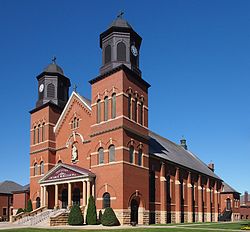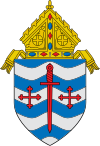
The Cathedral of Saint Paul is a Roman Catholic cathedral in the city of Saint Paul, Minnesota. It is the co-cathedral of the Archdiocese of Saint Paul and Minneapolis, along with the Basilica of Saint Mary in Minneapolis. One of the most distinctive cathedrals in the United States, it sits on Cathedral Hill overlooking downtown Saint Paul and features a distinctive copper-clad dome. It is dedicated to Paul the Apostle, who is also the namesake of the City of Saint Paul. The current building opened in 1915 as the fourth cathedral of the archdiocese to bear this name. On March 25, 2009, it was designated as the National Shrine of the Apostle Paul by the United States Conference of Catholic Bishops. It is the third-largest Catholic cathedral and sixth-largest church in the United States.

Harry Joseph Flynn was an American prelate of the Catholic Church who served as archbishop of the Archdiocese of Saint Paul and Minneapolis from 1995 to 2008. He previously served as bishop of the Diocese of Lafayette from 1989 to 1994.

The Archdiocese of Saint Paul and Minneapolis is a Latin Church ecclesiastical jurisdiction or diocese of the Catholic Church in the United States. It is led by an archbishop who administers the archdiocese from the cities of Saint Paul and Minneapolis. The archbishop has both a cathedral and co-cathedral: the mother church – the Cathedral of Saint Paul in Saint Paul, and the co-cathedral, the Basilica of Saint Mary in Minneapolis.

The Basilica of Saint Mary is a Roman Catholic minor basilica located on its own city block along Hennepin Avenue between 16th and 17th Streets in downtown Minneapolis, Minnesota. It was the first basilica established in the United States. The Basilica of Saint Mary is the co-cathedral of the Roman Catholic Archdiocese of Saint Paul and Minneapolis.

Our Lady of Lourdes Catholic Church is a Roman Catholic parish church of the Archdiocese of Saint Paul and Minneapolis located in Minneapolis, Minnesota in the United States. It was built on the east bank of the Mississippi River in today's Nicollet Island/East Bank neighborhood; it is the oldest continuously used church building in the city and is part of the St. Anthony Falls Historic District.

John Clayton Nienstedt is an American prelate of the Roman Catholic Church. He served as the eighth archbishop of the Archdiocese of St. Paul and Minneapolis in Minnesota from 2008 to 2015. He previously served as bishop of the Diocese of New Ulm in Minnesota from 2001 to 2007 and as an auxiliary bishop of the Archdiocese of Detroit from 1996 to 2001.

The Church of Saint Agnes is a Catholic church of the Archdiocese of Saint Paul and Minneapolis. The parish was founded in 1887 and the current church building was completed in 1912 and listed on the National Register of Historic Places in 1980.

St. John the Evangelist is a historic Roman Catholic Church at 2270 Massachusetts Avenue in Cambridge, Massachusetts.

St. Charles Borromeo Roman Catholic Church is a church located at the corner of Baldwin Avenue and St. Paul Avenue in Detroit, Michigan. The church address is 1515 Baldwin Street; ancillary buildings are located at 1491 Baldwin Street (Rectory) and 1480 Townsend Street. The complex was listed on the National Register of Historic Places in 1989.

Lee Anthony Piché is an American prelate of the Roman Catholic Church. He served as an auxiliary bishop of the Archdiocese of St. Paul and Minneapolis in Minnesota beginning in 2009, retired from public ministry in 2015, and returned to public ministry in 2023 as Vicar for Retired Priests.
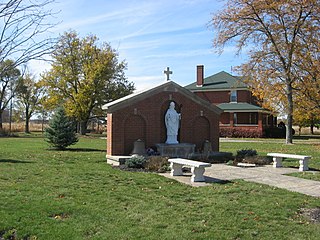
St. Patrick's Catholic Church was a Roman Catholic church in northwestern Shelby County, Ohio, United States. Located in the southwestern corner of Van Buren Township, the church sat at the intersection of Hoying and Wright-Puthoff Roads in the unincorporated community of St. Patrick.

Saints Peter and Paul Catholic Church is a former parish church of the Diocese of Davenport. The church is located in rural Solon, Iowa, United States. The property is on a gravel road east of Iowa Highway 1 between Solon and Mount Vernon in rural Johnson County. It was listed on the National Register of Historic Places in 1999.

The Saint Paul Catholic Church Complex is located at 157 Lake Shore Road in the Detroit suburb of Grosse Pointe Farms, Michigan. The group includes a French Gothic-style church, a Neo-Tudor rectory, a Colonial Revival parish hall, a Neo-Tudor school building, and an Elizabethan Revival convent. The complex was designated a Michigan State Historic Site in 1992 and listed on the National Register of Historic Places in 1994.
Józef Franciszek Darzyn Ciemiński was a Polish-born Roman Catholic priest. He emigrated with his parents to the United States in 1881 and was ordained as a Priest in Saint Paul, Minnesota in 1895. He was involved with numerous Polish Catholic parishes during his lifetime including the now closed troubled Parish of Saints Peter and Paul in Duluth, Minnesota, and the parish of Holy Cross in Minneapolis.

Church of Sts. Peter and Paul—Catholic is a historic church building on State Street in Gilman, Minnesota, United States. It was built in 1930 to serve a Polish-American congregation and designed in the Beaux Arts style by the Minneapolis architectural firm of Cordell & Olson. The first church was a log structure in 1872. It was known as the church of St. Wenceslas. Then a new church was built in the 1880s and was a frame structure known as St. Casimir's Church. The old log church was converted into classrooms. A new school building was built in 1909 and is present today. St. Casimir's church was destroyed by fire in 1891. A new and larger frame building was constructed for the new church. This church building stood north of the present brick building. The school building was completed in 1909. Fr. Vincent Wotzka as pastor had a brick rectory built in 1924. It was also designed by Cordelia and Olson. Sometime during these early years, the name of the parish was changed to Saints Peter and Paul. No reason has been found for the change. The church complex was added to the National Register of Historic Places in 1982.
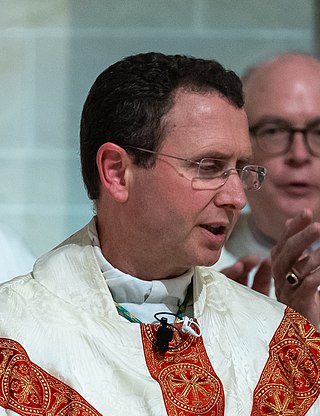
Andrew Harmon Cozzens is an American prelate of the Roman Catholic Church who has been serving as bishop of the Diocese of Crookston in Minnesota since 2021. He previously served as an auxiliary bishop of the Archdiocese of Saint Paul and Minneapolis in Minnesota from 2013 to 2021.
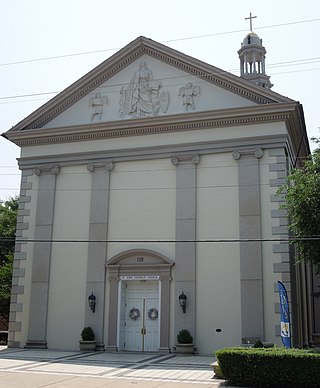
St. John the Evangelist Catholic Church is a parish of the Roman Catholic Church in Frederick, Maryland, part of the Archdiocese of Baltimore. Founded in 1763, after the repeal of the British penal laws, as the first Catholic church in Frederick County, the parish occupied two former buildings before the completion of the present Greek Revival church in 1837. At the time of its opening, the church was the largest parish church in the United States and was the first Catholic church to be consecrated in the Diocese of Baltimore. Today, the church remains the tallest building in the city of Frederick.

Donald Edward DeGrood is an American prelate of the Roman Catholic Church who has been serving as bishop of the Diocese of Sioux Falls in South Dakota since 2019.
